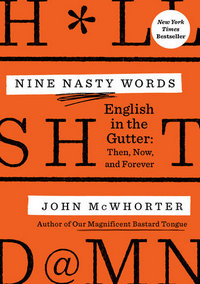 |
Nine Nasty Words:
|

What’s key is that the stock of curses is ever self-refreshing, The fashions change, as always and everywhere, but what persists is taboo itself, a universal of human societies. What is considered taboo itself differs from one epoch to another, but the sheer fact of taboo does not. Language cannot help but reflect something so fundamental to our social consciousness, and thus there will always be words and expressions that are shot out of the right brain rather than gift-wrapped by the left one.
What’s Nine Nasty Words About?
McWhorter looks at nine of the “bigger” profanities in English (with some asides to discuss related words), tracing their history, evolution, varying definitions, and contemporary usage. He points out periods where they were verboten, periods where they were perfectly acceptable—and what made them profane again.
The flow of the book comes from this thesis*:
On that matter of evolution, profanity has known three main eras—when the worst you could say was about religion, when the worst you could say was about the body, and when the worst you could say was about groups of people. The accumulation of those taboos is why “just words” like h***, s***, and n***** respectively harbor such sting.
I don’t know how accurate that is, but it kind of makes sense—and it works pretty well as a framework for the book, too.
* The book uses the actual words, I wimped out and elided them.
The chapter headings give you a pretty good idea of what the book covers and shows how the framework is used (with the addendum at the end):
1 D*** and H***: English’s First Bad Words
2 What Is It About F***?
3 Profanity and S***
4 A Kick-A** Little Word
5 Those Certain Parts.
6 Why Do We Call It “The N-Word”?
7 The Other F-Word
8 Being in Total Control, Honey!
9 A M************ Addendum
So, what did I think about Nine Nasty Words?
I largely enjoyed this book, I find the history and evolution of English fascinating—and while I try to eschew the use of profanity, I’ve found the development of those words very interesting—and I can appreciate a clever and inventive use of them in art.
This was a great look at those words—in particular, I enjoyed McWhorter’s demonstration of how the words function as various parts of speech, as well as the varying nuances of meaning. It was a clever mix of entertainment and education.
McWhorter has a great style, too, throughout the book he sprinkles little gems like:
To understand how language changes without allowing a certain space for serendipity is to understand it not at all.
The [N-]word is indeed twenty-first-century English’s Voldemort term,
The chapters on slurs—”words about groups of people”—mixed in a bit too much contemporary social commentary for my taste, but I’m pretty sure most people won’t agree.
On the whole, this was a great mix of entertainment and education, I doubt this is the definitive work on the subject (and McWhorter would likely agree), but it’s a solid work and I’m glad I read it.

This post contains an affiliate link. If you purchase from it, I will get a small commission at no additional cost to you. As always, opinions are my own.
![]()



wittysarcasticbookclub
This piqued my interest.